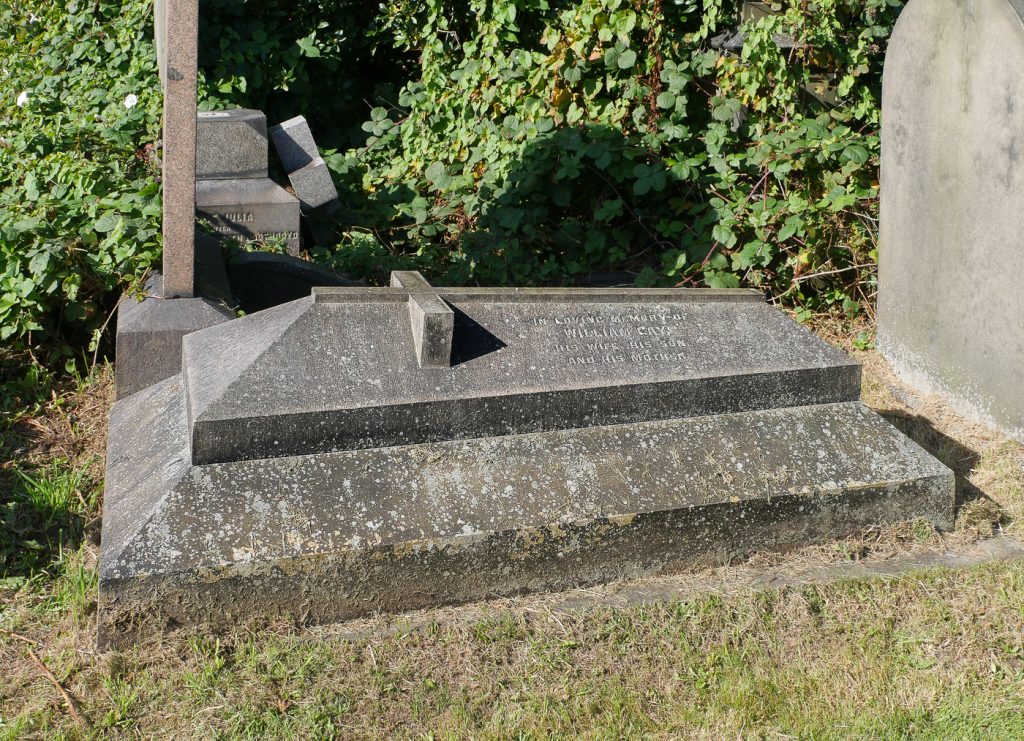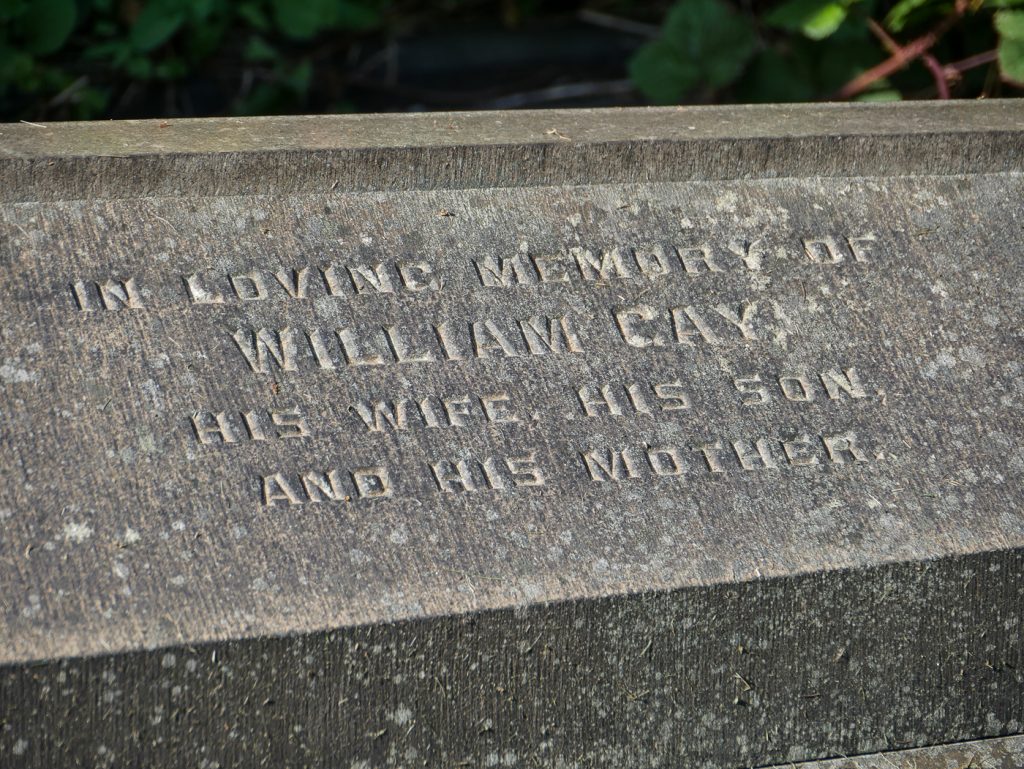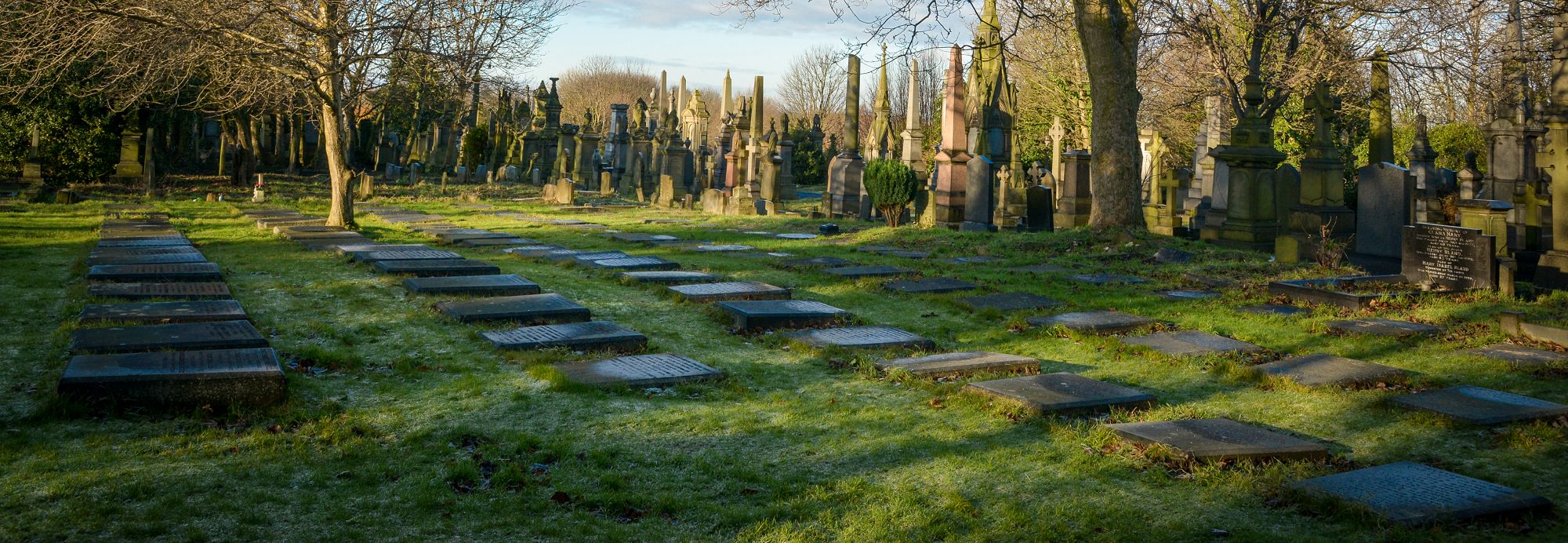William Gay
William Gay (1814–1893)
William was a British landscape gardener and surveyor who designed parks and cemeteries. In a list of Victorian cemetery designers, William Gay’s list of projects is the longest by far of those listed.
He was born in 1814 in Ross, Herefordshire and married Elizabeth Simmonds between April and June 1841 at Cheltenham, Gloucestershire.
William Gay moved to Leicesterr where in 1849 he was clerk of work at Welford Road Cemetery which was established under an Act of Parliament of 5 March 1848. On 19 June 1849 Mr. William Gay presented the Mayor with a brass plate to be placed within the foundation stone. On it were named the Mayor, Town Clerk, Stonemason, carpenter, Bricklayer and William Gay, Clerk of the Works. A workmen’s dinner subsidised by the Mayor was held for the workmen engaged in the Cemetery works at the Hind Inn, where 145 men and boys sat down to dine. Mr. Gay was Chairman and also proposed a toast to the Town & Trade of Leicester. This report took a whole page spread in high Victorian verbose phrases! In 1851 William was living at West Lodge, Occupation Road, St Marys, Leicester, Leicestershire, age 37, a Registrar employing under the Corporation 3 gardeners, one boy and 3 labourers. With him was his wife Elizabeth, age 37, and son William Simmonds Gay, age 9.They had just one 20 year old female servant.
While at Leicester, William was approached by the Bradford Cemetery Company to become Bradford Cemetery’s first registrar and manager. William moved from Leicester to Bradford to design and layout Undercliffe Cemetery over the years 1852 to 1854 at a cost of £12,000. Undercliffe Cemetery is one of the best examples of his work and one of the most striking achievements of Victorian funerary design. Hence its designation as Grade II*. In February 1853 a notice to Contractors for tenders for excavation work and Boundary Walling for Bradford Cemetery was issued adding that details were available from Mr. William Gay, registrar and Superintendant at the Cemetery Farm, Undercliffe. In June 1853 a notice to Contractors for tenders for erection of two Chapels, Registrars’ House, two Lodges and entrances for Bradford Cemetery was issued adding that details were available from Mr. William Gay, registrar, Cemetery, Undercliffe.
In 1855 William Gay won a competition to design the grounds of Toxteth Park Cemetery, Toxteth, Liverpool. The cemetery was opened in 1856.
On the 17 February 1857 the Burial Board of the Bradford Town Council were given 9 sites proposed for the new cemetery. these were whittled down to 4. With the assistance of William Gay, the Committee chose 2: 30 + acres at Scholemoor for £4,750 and 62+ acres at Bowling Park Estate for 6000 guineas, depending on one or both being chosen. On 14 May 1857 Mr. Gay reported that Bowling Park was nor the best as needed much drainage work, based on 13 excavations results fully detailed. The best by far is Scholemoor where the land is most suited and £2000 cheaper to develop than Bowling park. As Mr. Gay was a very competent authority who spoke much in favour it, the Committee agreed but referred it to the Mayor for overall endorsement. After much discussion the motion was carried 22 to 10.
In June 1858 Bradford Town Council were given three designs for the formation of a new cemetery, one by William Gay at a cost of £2750, in the middle of the other two. The Borough Surveyor on behalf of the Council would oversee this project.
In 1861William & Elizabeth were residing at 5, Pollard Lane, Bradford, but not with their son, and still one female house servant but this time aged just 16.
In May 1862 William Gay signed with a huge list of other folks a request for the Mayor of Bradford to hold a Public Meeting to consider the funds of Peel Park and how to free it from debt. In October 1862 The Oddfellows contributed £85 10s towards the liquidation of Peel Park debts. By May 1863 the debts had been paid and a Works Committee set up, including William Gay, now that Peel Park could be handed over to the Corporation.
Philips Park Cemetery, Manchester was designed by William Gay, with architects Paull and Ayliffe after winning a competition in 1863 from 40 entries submitted. The cemetery opened in 1866 and was completed in 1867.
In May 1865 William Gay, Architect, posted a notice inviting tenders for the building of 13 houses in Undercliffe Lane for the Guys Cliff Building Society.
In January 1866 William Gay as Secretary of the Bradford Cemetery Company gave notice convening the General Meeting of Shareholders. He did this each year at least until 1874. Also in January 1866, William Gay as Secretary of Undercliffe Cemetery, posts a notice that all persons having Freehold graves or vaults and not in possession of their title deeds should apply to the Registrar.
In 1867 William laid out Belfast City cemetery in the form of a bell (possibly reflecting the Bel in Belfast) and the cemetery opened on 1 August 1869.
In many editions of the Bradford Observer from March to July 1867 there was an advert for Offices to Let, several rooms lately in the occupation of Mr. William Gay, Architect, at 16 Kirkgate and also of Messrs. Smith & Gotthardt, Surveyors, which have a good entrance and are well lighted.
All issues of the Bradford Observer from April to November 1867 carried an advert by Mr. William Gay, the Sole Agent for Bradford, for Aberdeen Polished Granite Works.
In the Municipal Elections in 1867, William Gay was elected as Chairman for the East Ward of Bradford.
In October 1867 William Gay, along with many others, supported the election of a local man as their MP for Bradford.
The Bradford Cemetery Company was set up on 23 November 1867 with William gay as secretary.
The Partnership subsisting between William Gay & William Swallow, as Architects at Bradford, was dissolved by mutual consent on 30 June 1869.
In December 1869 William Gay (Surveyor) ran an advert inviting tenders for works at Saltaire Park near Bradford. In March 1871 the Park was making rapid progress, nearing completion and opening.
In February 1870 William Gay signed a petition along with Jacob Behrens & Titus Salt and 642 others requesting the abolition of duties on sugar, tea & coffee. Also in 1870 William Gay donated 1 guinea to “The National Society for Aid to the Sick and Wounded in War”.
In July 1870 the election of Churchwardens for Bradford Parish Church was seconded by William Gay who also made the proposal to appoint the churchwarden for the ratepayers and going on to give a vote of thanks to the Vicar.
In 1871we find William & Elizabeth residing in the Lodge at Undercliffe Cemetery with one female servant aged 19.
In March 1871 Rochester Corporation received 48 sets of designs for Castle Recreation Grounds & Public Walks. The design by Mr. William Gay of Bradford was declared to be the second in merit. £40 was awarded.
Also in March 1871 the Proposal of Mr. William Gay for the layout of Manningham Park for 200 guineas came before the Town Council for acceptance. The Committee could scarcely meet with a surveyor of this particular class who could come anything near to Mr. Gay in competition. Mr. Gay ranked very high in this kind of surveying. Motion carried by a large majority.
William also designed and laid out Roberts Park (originally Saltaire Park), Saltaire for Sir Titus Salt and this opened in 1871. It is part of the model industrial town of Saltaire.
In February 1873 a notice to contractors to tender for Boundary Walling, Excavations, Roads and Drainage for Brighouse Cemetery was signed by William Gay and F. B. Payton, Architects. Another similar notice of February 1874 requested tenders for Trees & Plants including planting.
Also in February 1873 William Gay, Architect and Surveyor posted a notice to contractors to submit tenders for excavations, roads and drainage within Pudsey Cemetery. Another notice in September 1873 for tenders but for Carpenters & Joiners for erection of Chapels, Vestries & Mortuaries.
William landscaped Lawnswood Cemetery in Adel, Leeds and assisted architect George Corson with building design. The cemetery opened in 1874 for the Headingley-cum-Burley Burial Board.
In August 1974 the New Cemetery at Lightcliffe Road, Brighouse was consecrated. The layout of the grounds and the planting had been designed by Mr. William Gay.
In October 1874 William Gay, Architect, posted a notice to contractors to tender for draining, boundary walling, formation of walks and surface of the grounds of Low Moor Churchyard extension with details available from him.
A Cemetery for Pudsey was decided on 14 March 1870. In February 1873 a notice for tenders for Roads and Drainage was posted and in May 1873 a similar notice posted for Boundary Walling, Entrances, Iron Gates & Railings, followed by one for Gardeners to form the surface in May 1874. The Consecration of the Pudsey Cemetery was made on 21 May 1875. The Architect & Surveyor appointed by the Burial Board to carry out the design of the cemetery was Mr. William Gay. It cost a little under £10,000. It was listed in the top ten Victorian and Edwardian buildings most at risk in England and Wales as published by the Victorian Society.
In 1876 Mr. William Gay was elected as a Town Councillor.
In February 1876 a notice was posted of an enquiry into an application of the Undercliffe Cemetery Company to extend their burial ground by about 4 acres at which William Gay was present. The meeting was adjourned pending drainage reports. The extension was abandoned in May 1876, William Gay being involved in this decision.
In May 1876 only two plans for the layout of Horton Park were submitted to the Council, one from Mr. William Gay of Bradford, the other from some Manchester Surveyors. Development had started in 1873 and the park opened on 25 May 1878.
In August 1876 William Gay purchased 3 acres of ground belonging to Airedale College. Undercliffe Cemetery directors intended to purchase about 8000 yards of this land from Mr. Gay.
In June 1877 William Gay of Little Horton Lane was fined 25s for keeping a dog without a license!
In December 1877 Mr. William Gay attended the consecration of St. James’s Church, Bolton.
In February 1878 foundation stones of two Chapels about to be erected in the Undercliffe Cemetery were formally laid. The total cost of these buildings was to be about £7000.
A notice was put in the Bradford Observer of 15 May 1879 by William Gay, the Secretary of the Bradford Cemetery Company, stating that the new Cemetery at Undercliffe will open on the 21 May 1879.
In 1891 William & Elizabeth are residing in Charnwood Road, Eccleshill, Bradford, Williams’ occupation being a Surveyor & Landscape Gardener.
William died between January and March in 1893, Aged 79, in North Bierley, Yorkshire. His burial entry dated the 11th March 1893 gives his address as 43 Charnwood Road, Undercliffe, Bradford.
Further works by William Gay: –
The surveyor of Chorley, Lancashire cemetery James Derham, consulted William Gay who went on to prepare the design of the cemetery grounds using his favourite devices of a promenade, viewing platform, and raised and sunken terraces.

One of the most important graves in the cemetery, that of William Gay
To find the grave using the what3words App follow this link and select satellite view.

Research by David Broomfield April 2019

